7-minute read
Quick summary: Seven change management trends are shaping how organizations will evolve their approach to change, and change management consulting experts are helping them navigate these unknown waters.
We’ve had lots of practice dealing with change over the last several years; fortunately, the discipline of change management was there to help us along, with proven strategies for guiding workforces through choppy, increasingly unpredictable waters. Along the way, approaches to change management consulting have evolved and continue to do so. Today we’ll look at seven trends that are shaping the future of change management and its role in the ever-transforming workplaced.
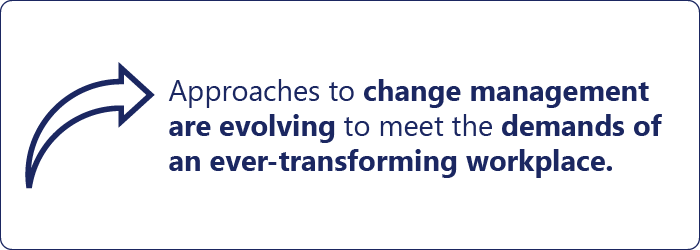
1. Transitioning from awareness to expectation
Before the pandemic, change management was in many ways the unsung hero of mainstream business management. When change became the rule rather than the exception,organizations across industries began to see and appreciate the value of change management consulting. In a study by Gartner, 48 percent of HR leaders surveyed said that change management will be a priority in the coming year.
Today, awareness of change management has evolved into a standing expectation. Today’s employees know that change isn’t something they need to deal with only once or twice a year—and that staying still isn’t an option at either organizational or personal levels. Whenever change happens, team members at every tier, from the C-suite to the factory floor, have come to expect the support that only effective change management can deliver.
2. Managers stepping up as change agents
As the pace of change accelerates, more organizations are expecting employees at manager level and above to become educated in change management practices. The ability to empathetically and effectively guide employees through change is no longer a “nice to have” for managers, nor should designated change managers be expected to handle every aspect of every large-scale initiative.
Change-related requirements are already working their way into job postings for manager-level positions, and we are starting to see more companies invest in coaching and skill-building in this area for current leaders. Department leaders are also realizing that subject-matter expertise is often easier to acquire than change-management skills, so we could be seeing many more promotions that reflect this reality as well as engagement of change management consulting services.
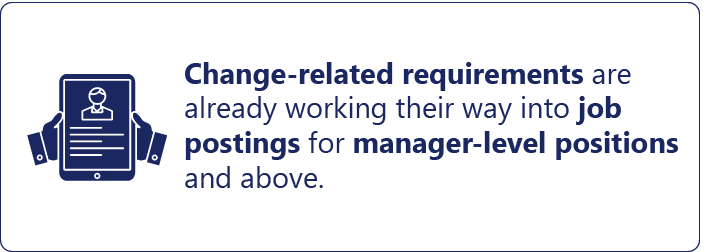
3. Incorporating change into company cultures
The ability to adapt to change has become a standing expectation of employees among companies of all sizes, and we’re starting to see this trend reflected in company values, mission statements, and cultural goals. Terms like “flexible,” “agile,” and “learning/growth mindset” are popping up in the language organizations use to talk about themselves at the highest level.
To put it another way, companies are going beyond simply “making peace with change.” Today they’re working with change management consulting resources to proactively re-tune themselves and improve their ability to adapt to whatever disruptions—positive and negative, major and minor—may lie ahead.
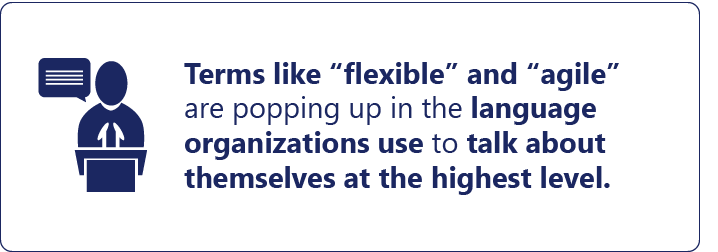
4. Humanizing change
Companies are starting to see change management as something they want to do, rather than just a necessary element for implementing or adapting to changes efficiently. This desire to help employees manage change can inspire investments above and beyond the bare minimum, encompassing tools, people, and processes to address employees’ emotional needs as well as what they need to get their jobs done. Change management consulting experts help accelerate the “humanization” of change through proven practices that give every employee a stake in the goals of the change initiative.
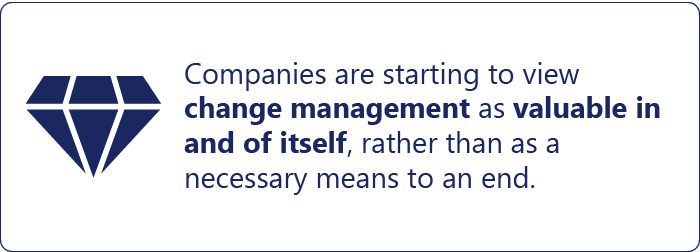
5. Highlighting the value of authentic leadership
With work-from-home now a permanent fixture in many organizations (at least as an option), leaders and change management consulting teams are facing new challenges in their efforts to engage employees. When change is on the horizon, employees are more likely to engage with leaders they trust, and that trust begins with authenticity.
According to the Gartner study, employees with high trust have 2.6 times greater capacity to absorb change than those with lower trust levels.
Contrary to a popular belief that you “either have it or you don’t,” authentic leadership can be learned and implemented by any leader at any level of the organization. When helping employees deal with change, authentic leaders can be particularly effective in the area of decision making. Employees appreciate being told how leaders arrive at their decisions and seeing how each decision reflects an authentic desire to do good for the company. By being authentic with the teams in their care, leaders can deliver positive, effective change more quickly and smoothly than their less-transparent counterparts.
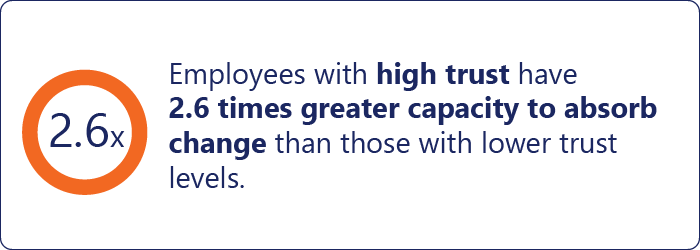
6. Becoming data-driven
Organizational initiatives across the board are becoming more data-driven, and change management is no exception. Historically, gathering change management data has involved surveys, surveys, and more surveys. Today, change managers have many other avenues at their disposal, including
• Single-question intranet polls (everyone has time to answer one question!)
• Mobile apps geared toward employee engagement, such as Culture Amp and Tinypulse
• Social media, particularly for changes impacting customers
• Internal social platforms such as Yammer
• Utilization data for new tools and/or processes
It will be interesting to see how the change manager’s data toolbox continues to evolve, with the help of change management consulting resources. Today AI tools being leveraged to more accurately gauge employee sentiments, highlighting the emotional aspects of how employees process change.
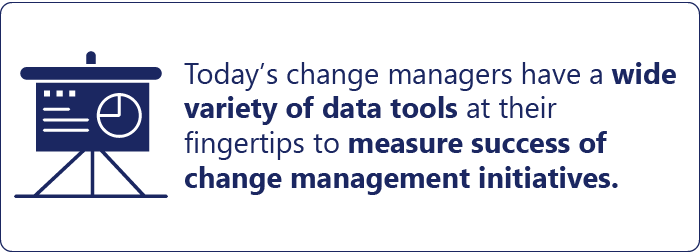
7. Evolving approaches to communication
The evolving workforce requires increased transparency, greater attention to relevance, and clearer ties to the company’s values and mission. I like the advice Gartner shared in a recent report: focus communication on “talking,” not “telling.”
The “Great Resignation” reflected a fundamental shift in employee priorities. During the pandemic, many people took stock of their lives and came to the conclusion that they needed to work for companies that fit their values and their passions. As a result, thousands of employees pursued opportunities elsewhere as soon as the economy began to recover, leading to significant personnel disruptions.
To prevent a localized “great resignation” from happening on their own turf, organizations are engaging change management consulting to help them deepen emotional ties with their team members—a major shift from the traditional employer/employee relationship. How do you do that with a dispersed workforce? Through carefully planned communications.
Change managers are starting to deliver more transparent, meaningful communications that tap into emotional experiences. This pivot in approach incorporates practices such as being honest about changes and processes—particularly the why behind the what—as well as admitting uncertainty and owning up to failures. The employee of 2022 has little patience with fluff and platitudes, being far more likely to respect a message along the lines of “this is what we’re trying, and we’ll see how it goes.”
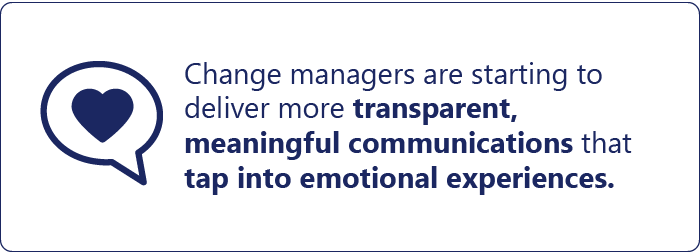
As the workplace continues to evolve, one thing is for certain. We will have to deal with change—from rapid disruptions to slower evolutions, from far-reaching transformations to minor process tweaks. And if this year is anything like its recent predecessors, we’ll have to do it often. The good news is that we’re getting better at it, and the practice of change management consulting is evolving right along with us. By keeping these seven trends in mind and implementing new best practices, we can help employees, customers, and partners feel good about implementing and adapting to the changes that will shape our future … whatever that looks like!
Like what you see?

Tennille Gruman is a change manager at Logic20/20 with 14+ years of diverse experience in the retail, legal, agricultural, and hospitality industries and a passion for people, culture, and technology adoption.

